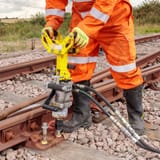>>2932715>I'd think the switch would've been more common even before the fancy electric stuff.Reliability is heavily weighted in industrial decision-making. Heat accelerates wear. Lack of lubrication accelerates wear. Air motors don't generate heat (in specific cases, they can need heat sinks because they get too _cold_), and air-powered tools often have lubricant added regularly or even constantly.
Electric motors generate heat. While the tools themselves aren't inherently more difficult to lubricate, it's easier to ignore that facet of their maintenance than with air tools, it seems. Electric motors also require insulating parts, which are almost always some kind of polymer or ceramic. Polymers often have problems with brittlenes and degradation when exposed to heat and petroleum products. Until very recently, electric motors had to be huge to even come close to matching air motors, and that gap has merely shrunk, not disappeared. All of this adds up to electric tools being heavier and less reliable, and almost always more expensive up front in an apples-to-apples performance comparison.
Additionally, a huge portion of industrial settings already require compressed air for other processes or machines. It sort of just makes sense to use pneumatic tools if you already have an extensive air system. The ONLY real downsides are that they can't be cordless (not usually a huge issue in industry) and running cost (which IS a huge deal in industry). And those running costs, while potentially significant, are trivial when considered as a portion of overall operating expenses. The reliability, repairability, and lower initial investment for pneumatics generally sees them favored, in the end. While high-performance electric motors have cut into this edge somewhat, it's unlikely any industry will abandon pneumatic tools entirely any time soon.
